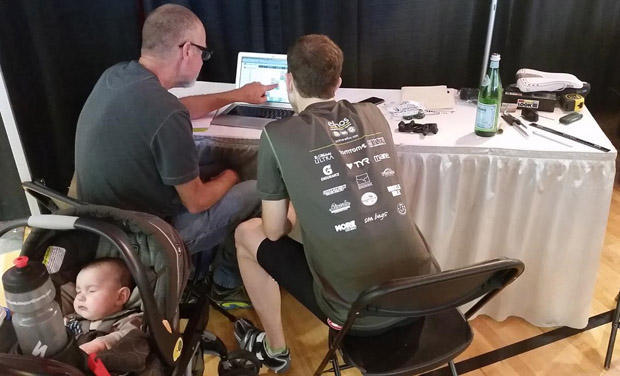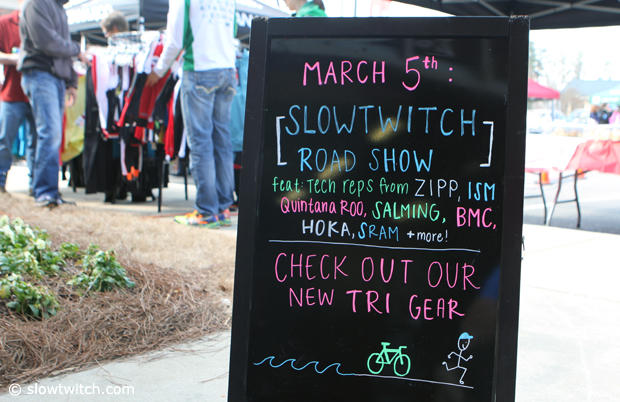The Transaction
Donald Trump may indeed be a great dealmaker. But selling expensive and technical gear to triathletes requires a special effort that might even confuse The Donald.
I've been thinking about this over the last couple of weeks while traipsing about the country attending Slowtwitch Road Shows. That is one thing The Donald and I have in common these days: traipsing about the country.
What I've noticed is the ability to transact – manufacturers and consumers making a match – is hit and miss. Channeling my inner Donald, when I sold triathlon products there was a lot of winning, amazing winning, believe me very, very good winning, while low-energy others were horribly losing.
But, look, any success I had was out of desperation. Yes, I was a triathlete for a long time before I made anything for triathlon, and even that was an accident. What I had in 1986 was a new product that I did not set out to make. It was not simply a product, but a new category. To those resistant to history, I have proof!
You might think it's easy to sell a triathlon wetsuit when you've got the only triathlon wetsuit. Not so. First you have to convince people they need one and that it's faster than swimming without one. I spent many weeks during the first half of 1987 driving up and down California, hitting the masters swim teams, Bakersfield, Fresno, up to Sacramento, standing on pool decks, begging swimmers to put the darned thing on and swim out and back. Just give me 50 yards of your time. If you're not convinced I'll leave the deck and let you swim in peace.
Where do you sell such a thing? Through run stores? Surf or dive shops? Bike shops? I decided it would be bike and run stores because, as Dillinger might say, that's where the (triathlon) money is.

Hundreds of times I picked up the phone. “Hello, you don't know me, I have a product I think you should consider selling. It's a wetsuit.”
“Sir, you have the wrong number. We're a bike shop.” Click.
But I was persistent, and two years later I was back at them, selling a bike with a seat angle of 80 degrees. Now they knew for certain I was crazy. But I did have one advantage: They had success selling that silly wetsuit of mine. Would they double down?
The original owner of Nytro Multisport, Craig Turner, refers to Quintana Roo as the brand that built Nytro. He started that business out of his garage (I started mine out of my walk-in closet). In truth, these early triathlon stores like Nytro and Inside Out Sports built Quintana Roo just as QR built them right back. We, along with companies like HED and Zipp and eventually De Soto and Cervelo rose up as triathlon's manufacturing industry. We all built each other. HED and I shared every trade show booth from my first trade show, in 1987, to my last as an exhibitor in 1998. We started sharing because I couldn't afford my own booth. We continued sharing because it was us against the world.
We learned. We adapted. We generated skills and, honestly, as I travel the country today and watch how stores and employees and sales and tech reps and consumers engage in transactions some brands have it down. Others, not so much. Yes, it takes two to transact, and many would-be transactions are foiled because the consumer doesn't take seriously the processes invented to make his decision making easier and more precise.

In the beginning there was no pathway to sell a triathlon wetsuit. Stores didn't want them. I had no money. I got a job waiting tables at night to pay for rubber (and rent). Further, there was no consumer demand. No one knew he needed a wetsuit. I had to go out to where the triathletes were, to masters swim practices, and to races. Most races did not have an expo (the expo was still mostly in triathlon's future back in 1987).
“Can I sell my wetsuits at your race?”
“What do you mean? It's a race. People just come to race, not to buy stuff.”
“If I give away two of my wetsuits as prizes at your race, can I sell my wetsuits out of my van?”
“Well, in that case sure.”
I bought an old orange Dodge Van for $750, which I could sleep in the night before the race, and then open the doors and sell and demo wetsuits the morning of the race. I named it Magic Fingers because it had a bad U-joint and vibrated above 50 miles per hour.
There wasn't much interest in my wetsuits before the race. But there sure was after the race, when everyone in a wetsuit swam away from everybody without one. That was the start of my first triathlon company, Quintana Roo. My earliest convert was Mark Montgomery (Monty on the forum), and he and I spent the late 80s and 90s selling the hell out of triathlon wetsuits, race expo by race expo.
After I sold my company and started Slowtwitch (in 1999), and was just about ready to emerge from non-compete jail in 2001, I approached my buddy Emilio De Soto and told him about a wetsuit design that had been knocking around in my head. I went back and got one of my old QR factory employees and we made patterns. The result were De Soto's 2-piece designs (Emilio, pictured below circa-1990 on an early Quintana Roo tri bike, has ably taken those designs his own way since then).

Monty and I had just moved up to The Compound in 2002, we were next door neighbors now, and the two old expo kings hit the trail once again.
This time we were the guys selling the kooky cult wetsuit amid all the normal wetsuits. Not to worry. We'd had it harder than this. “The proof of the pudding is in the swimming, sir. Here's a wetsuit, try it on, go out and swim in it.” But that wasn't enough. We strategized the transaction. We put our expo booth right where everybody must go to pick up their race registration bags. We did not need a chair at our expo booth. There was no sitting. I accosted everyone who walked by with “Hey, what wetsuit are you swimming in tomorrow?”
“Who, me? An old Aleeda.”
“You know that wetsuit is worth money to me.”
“Really?”
“Yeah. Why don't you try on one of these? How much do you weigh? I'll give you good money for that Aleeda. You deserve a better wetsuit; this one I've got is the state of the art.”
So Monty and I sold that fellow a $400 wetsuit for $300 plus that old Aleeda. We did that all day long at our first expo. At the next expo we hung a sign that said, “Wetsuits, $25 and up.” We didn't need to accost anybody; they made a beeline for our sign. “You have wetsuits for $25?”
“Yeah, I've got an Aleeda that looks like it would fit you fine.”
Monty and I amassed hundreds of used wetsuits that way. We bought wetsuits that came in for warranty from other wetsuit companies. Cash is king. You show up in November, back your truck up to that wetsuit company's roll-up door. “Got any old ripped wetsuits? They're worth cash to me.” We sold wetsuits from $25 and at every price point.

Retailers complain that XTERRA has cannibalized their wetsuit business and XTERRA is a formidable seller and an admirable competitor. But it doesn't sell $25 wetsuits.
Hey, I got a million of ‘em. If I see you at a Slowtwitch Road Show I'll tell you some of the old stories, including one or two I can't print.
When you come to a Slowtwitch Road Show to an appointment where I prescribe your complete bike solution do you know what that is? Yes, it's you discovering what bikes are your perfect matches. It's also me paving a pathway to purchase. Without that pathway the retailer is one blind elephant holding the portable credit card machine, and you are the other blind elephant trying to stick your card in. All the appointment-only activations at Road Shows are pathways to purchase. They aren't simply methods of extracting money from consumers; they are also ways to match consumers to products, giving the consumer confidence that his or her money is well spent. That is a smart transaction. But it was a transactional process built out of necessity – even desperation.
To the degree I have been successful – and my success has only been marginal – it is because I always thought about how to sell before I entered the selling arena. I went with a plan. When my plan failed, I didn't get discouraged. I got mad. Mostly at myself. I changed the plan, making the pathway to the transaction smoother, easier, more precise, more compelling, harder to resist. I found a way to stay alive while I kept changing the plan. If the plan kept failing I kept getting madder. And worked harder. Eventually the plan worked.
Quintana Roo wetsuits and bikes, F.I.S.T., Slowtwitch, have all been exercises in trying, failing, getting mad, and creating a better pathway to the transaction. Our new Reader Forum is a newer, better, pathway to the transaction (me serving content and you reading it is the transaction).

With today's technologies smart transactions should be commonplace. Nevertheless, the ability to transact in a smart and artful way remains elusive, mostly because “smart and artful” will sink without “stubbornness and struggle” to keep it all afloat while the process is getting honed. Every company, every salesman, every race director enjoys those blessed seasons when the fish swim into his net. I'm writing today about how to prevail in those other seasons.
Whether it's getting a non-triathlete to sign up for a race, or getting a triathlete into my new product, my secret weapon has been the understanding that my failure is my fault and not the fault of my customer. My advantage was in my willingness to try new approaches, to develop systems and pathways that made it easier for the customer to transact. And, I had the stubbornness and persistence and maybe – in between bouts of depression and terror – just root meanness to keep going until I pushed through.





